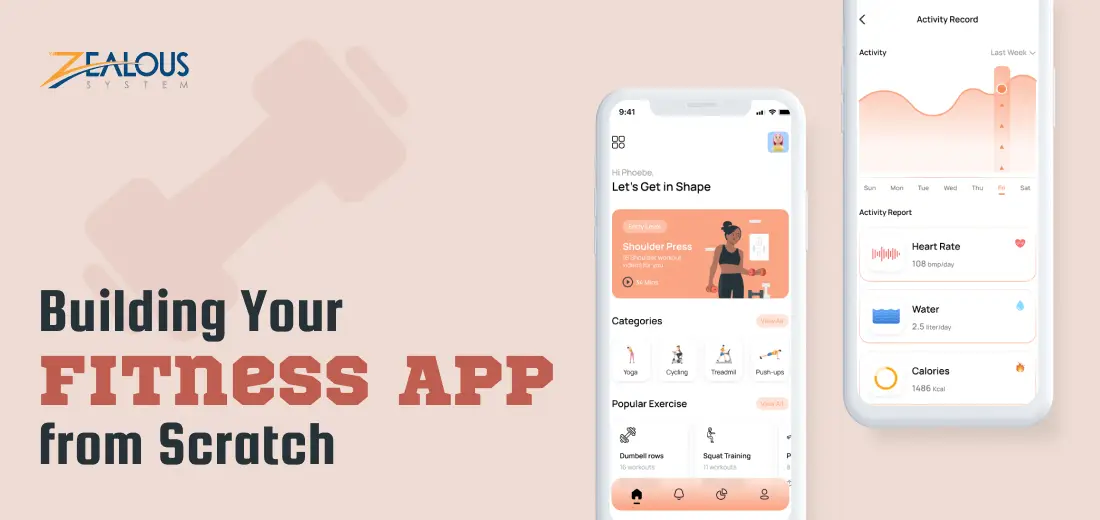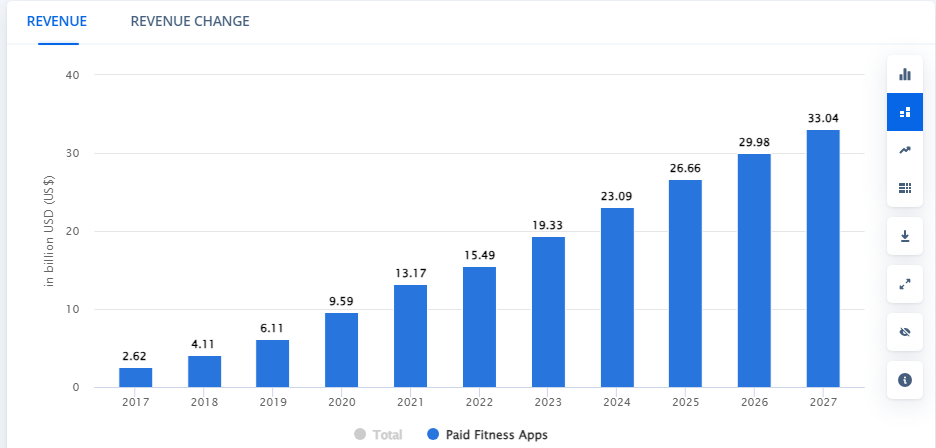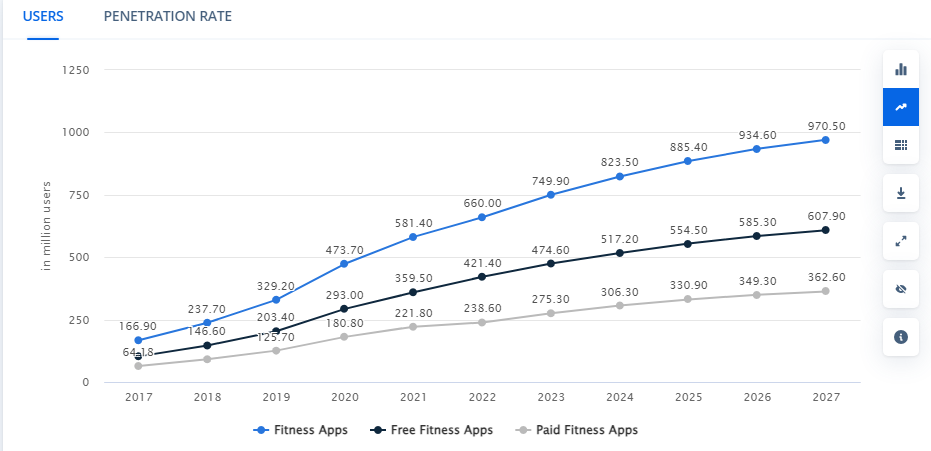


The increasing use of smartphones and wearable devices has boosted the popularity of fitness apps, making them an essential part of health and wellness. In 2023, users spent $188 million on fitness apps each quarter, and total downloads reached 858 million for the year. The future of mobile fitness apps looks promising, with the global market expected to grow to $4.8 billion by 2030 at a 17.7% annual growth rate from 2024 to 2030.
With this growth, many business owners are investing in fitness app development to enter the market. However, standing out in a competitive app industry requires careful planning, a user-friendly design, and a clear understanding of your target audience.
Whether you want to create a fitness app, are passionate about fitness, or are curious about health technology, this blog is for you! You will learn how to build a fitness app that works well and stands out in the growing market.

Source: statista

Source: statista
More people now understand the importance of staying healthy and fit to avoid chronic diseases, improve mental health, and enhance overall well-being. Fitness apps help users reach their fitness goals by offering personalized workout plans, tracking progress, and providing motivation and support.
Smartphones are now common worldwide, with billions of people using them. This makes it easy for users to access fitness apps anytime, anywhere.
Smartwatches and fitness trackers are becoming more popular. These devices can monitor various fitness metrics like steps, heart rate, and sleep quality. When connected to fitness apps, they provide users with more data and insights to help them achieve their fitness goals.
Fitnеss and workout apps еncompass a divеrsе rangе of catеgoriеs, еach sеrving specific purposеs and offеring distinct fеaturеs. Hеrе’s a brеakdown of some common typеs:
These apps work like digital records for your physical activities. They keep track of your daily movements, including steps taken, distance covered, and calories burned. Some even monitor your sleep patterns. Fitness trackers give you a clear summary of your daily activities and health data.
If you want a well-structured exercise routine that matches your fitness goals, workout apps can help. They offer guided workouts for weight loss, muscle building, and cardio fitness. These apps include expert-designed workout plans, video demonstrations, and progress-tracking tools, making them like virtual personal trainers.
Yoga and meditation apps are great for improving flexibility, strength, and mental well-being. They offer peaceful guidance through sessions led by experienced instructors, helping users practice yoga and meditation effectively. These apps usually have sessions for all skill levels, so it’s easy to find the right one for you.
Whеthеr you’rе an еxpеriеncеd athlеtе or a novicе in running or cycling, thеsе apps provе invaluablе. Thеy utilizе GPS technology to rеcord routеs, distancе, spееd, and pacе. Additionally, thеy can assist in crеating pеrsonalizеd training plans and monitoring progrеss, making thеm idеal companions for optimizing outdoor workouts.
Achieving fitness goals isn’t just about exercise; nutrition plays a key role. Nutrition apps help you track your food intake and calories. Many apps have large databases with detailed nutritional information about various foods.
Thеsе divеrsе fitnеss apps catеr to a widе array of individual wеllnеss journеys, offеring a wеalth of fеaturеs and rеsourcеs to support usеrs in thеir pursuit of bеttеr hеalth.
Creating a fitness app requires careful planning and execution to ensure its success. Here are 10 steps to guide you through the process:
When developing a fitness app, it’s important to first decide on your idea. Whether it’s guided meditations or on-demand workouts, each type of app has unique features that affect the development process.
Identify a problem you want to solve, research the market to see if it’s profitable, and look at the top-grossing apps in your niche. This will give you the information you need to make an informed decision.
Market research is a crucial first step in developing your fitness app. By studying market trends and competitors, you can understand key players, important features, and common mistakes.
Before you begin development, it’s also important to have a clear picture of your target user. Look at your competitors’ users, conduct interviews, and create user personas that outline their needs, problems, and interests. This competitor data and customer feedback will help ensure your fitness app reaches the right audience with the right features.
Hiring experienced app developers is crucial for creating a successful health and fitness app. Ensure that your tech partner has a solid history of working on similar projects and understands your business goals.
You can choose to hire an in-house team or outsource the entire development process to a vendor. While both options have their advantages, outsourcing stands out for being more affordable, offering high quality, and speeding up the hiring process.
Now that your team is ready, it’s time to break down your business idea and turn it into a proven concept. Your development team will bring a fresh perspective to your business analysis and provide valuable, actionable insights.
At this stage, your initial research is enhanced by the development team’s vision. Together, you’ll define and refine key app features, user personas, and customer journey maps. Based on this teamwork, you’ll further develop your value proposition.
In the end, the research process becomes a brief summary that includes competitor analysis, audience research, and the main goals of your solution.
Now that the planning is complete, it’s time to focus on how your digital product will look and feel. Your UI/UX designers will create several prototypes based on user personas and market research. These prototypes will be tested with a group of target users.
A prototype is an early version of your app’s interface. It doesn’t have any code but simulates the user flow of the final product. The prototype that gets the best feedback will become the final design. After that, the finalized screens are handed over to the development team.
In the end, your interface design should be simple, intuitive, and free from unnecessary elements, like a lengthy login process. For example, an app should take the user straight to their workout, with easy access to registration, onboarding, schedules, goals, and other important screens.
In this stage, developers choose the right technology stack to turn your fitness app idea into a fully functional product. The choice depends on your company’s technical maturity, app needs, and budget. The development team plans the app creation process and documents key milestones in the following materials:
A minimum viable product (MVP) is the first version of your fitness app. It includes only the essential features, so you can test your product idea without investing too much time or effort in all the features.
At this stage, the QA team checks the MVP to make sure it meets the business goals and technical requirements. Once the MVP is ready, developers launch it on the Google Play Store or App Store to gather feedback from real users.
The final step in development is adding extra features to your MVP. After that, the solution is tested for bugs and inconsistencies before being released to users.
To ensure your app stays successful in the long run, it’s important to update and maintain it regularly. Ongoing support will help your app stay compatible with new platform versions, meet changing user needs, and stay competitive.
You should also monitor your app’s performance using tools like Firebase or Mixpanel and keep an eye on user reviews for bug reports and suggestions for updates.
There are several monetization strategies available for your fitness app, each catering to different user preferences and business objectives:
With this model, users pay a fee to download and install your app. The cost usually starts at $0.99. This option works well if your brand already has a large following and the price is low. However, new brands and startups often avoid this model. For example, only 3% of apps on the Google Play Store in 2024 required an upfront payment to download.
This strategy involves selling items or services inside your app. These can be physical products like gym gear or virtual goods such as extra training plans or nutrition tips. Users pay a one-time fee to unlock these features.
With this model, you make money by displaying ads in your app. Ads can include banners, out-stream ads, or native ads that blend into the user experience. However, video ads can disrupt the user experience, especially in apps like meditation or yoga, where interruptions can be a problem.
The freemium model lets users download and use your app for free, but some features are locked. For example, users may need to pay a recurring subscription fee to access premium features like advanced fitness plans or ad-free content.
In this model, you partner with brands, gyms, influencers, or other businesses to display their promotional content in your app. You get paid by the advertiser for sharing their media, offers, or deals on your app.
The fitness app market is poised for substantial growth, driven by factors such as increasing health consciousness, widespread smartphone usage, and the popularity of wearable devices.
To develop a successful fitness app in this evolving landscape, it’s crucial to thoroughly understand your target audience and keep a pulse on industry trends. Your app’s type and features should cater to user needs, and careful budget planning and the right team are essential for development.
Prioritize user experience during design and development, and select an appropriate monetization strategy, whether it’s subscriptions, in-app purchases, advertising, or affiliate marketing. Regular updates and proactive promotion are vital for engaging users and ensuring the long-term success of your fitness app in this dynamic and promising market.
One thing is certain: the demand for fitness apps will continue to grow. People are increasingly turning to technology to improve their health and fitness, and the opportunities for innovative fitness apps are boundless.
So developing a fitness app is a strategic step to have a strong foot in the ever-changing technology market.
Our team is always eager to know what you are looking for. Drop them a Hi!
Comments